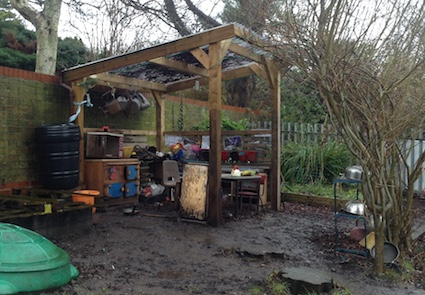
When I was in the middle of writing Messy Maths, I had the opportunity to visit Quackers Playgroup, whose mud kitchen featured in Muddy Faces and Jan White’s Mud Kitchen booklet. Over the years it has evolved, based upon observations of how children use the space particularly by the owner and co-founder, Menna Godfrey.
The mud kitchen grabbed my attention as soon as I stepped into the outdoor area. The staff have observed that every day the children use the place in a different way. This to me suggests that this mud kitchen is serving its purpose very well as a context for learning through play. This led Menna and I to spend time discussing why this is the situation.
The layout and design of this mud kitchen particularly fascinated me. I immediately saw that Tom Bedard’s dimensions and elements were in place. I could see the parallels between how he sets up his sand table and how the Quacker’s mud kitchen has evolved naturally through the staff observing the children’s play and developing the mud kitchen so that it is fit for purpose. Both Tom and Menna ensure that children are given time and freedom to play. Their interests drive the tweaks, changes and transformations which happen.
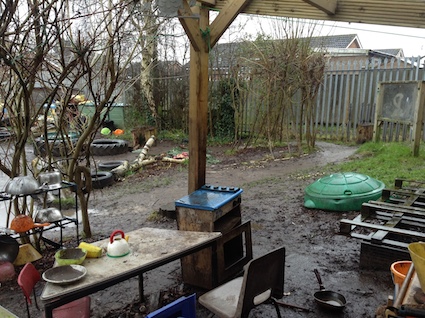
- Orientation – horizontal, vertical and incline
The mud kitchen is situated on a small slope (incline) so has prominence within the outdoor area. It means from the mud kitchen, children have a good view of their surroundings. Perhaps this can help with decision making within play as a child can see and be inspired by other parts of the outdoor space.
Tom states “Children are naturally drawn to pouring, rolling, or sliding materials and objects down ramps, chutes, and tubes.” At Quackers, the slope provides this opportunity. The added advantage is that children can also move up and down the slope and cycling up and down it was also a popular activity.
The mud kitchen has two vertical panels that provide a corner where they meet. So there is a sense of enclosure for children who need this – they don’t have to be distracted by the view and surroundings unless they want to be. My proposition is that placing panels perpendicular to each other (so that there is one corner) creates a higher play affordance than simply a mud kitchen that is purely against a wall without a perpendicular element. My reason is that it seems to encourage greater interactions between children rather than simply playing alongside each other.
The vertical panels are different – the perpendicular one has slats and can be accessed from either side. A child on the other side of this panel can therefore interact with children in the mud kitchen. Resources can be hung here too. This increases the play possibilities compared to a mud kitchen that is tucked away in a corner.
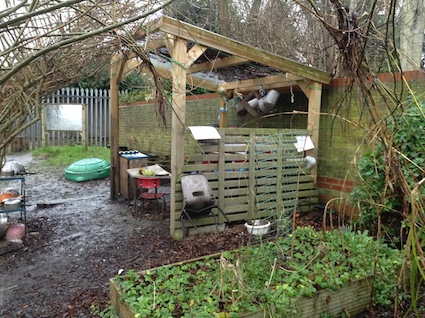
Within the mud kitchen the horizontal surface has the usual storage areas. They are quite busy. Several years ago, the children decided to move an old table into the area. It has remained there ever since providing an important additional surface for an array of different activities.
- Levels
Tom suggests that levels are important for children to experience space. He advocates thinking about the ground, middle and upper – or stretch zone. “Children will find all the different levels of play for any given apparatus. They will use all levels of play including the highest and the lowest which includes the floor.”
At this mud kitchen, one of the supplies of mud comes the old site of the mud kitchen -the large floor-level raised bed to the left of the mud kitchen. The horizontal surfaces within mud kitchen provide working space, but also the features such as the oven and the storage of some resources are all at different levels.
Above the height of the children there are more resources – look at the string of pans and kettles hung up. For the children to access these, they must either ask an adult or find some way to reach them. The vertical slat panel is a key stretch point. All sorts of items can be posted through or put up and over this feature.
- Open/closed spaces and holes
Tom observes that children are fascinated with spaces. We need to offer or enable children to create spaces over, under, around and through. The spaces can be of various sizes to encourage exploration. Tom says “children will explore all spaces in any given apparatus no matter how big or small. More spaces equals more exploration.” I would suggest this is also true of any outdoor space. Children like to know it intimately. It not about the physical size of a space. It is about creating spaces within spaces that are a source of fascination to children. If you think about Russian dolls, we can apply a similar thinking to outdoor spaces and holes within holes or nooks within crannies.
I would suggest that outside, this happens on a significantly larger scale. One thing I noticed here is how the children used the tyres and puddles as “spaces.” In front of the mud kitchen, willow has been planted. This is a long-term project to provide natural shade and shelter. Currently a transparent corrugated roof does the job and when this ends its life, the willow should be large enough to create the sense of “open enclosure.” This may sound like a strange term but I use it to describe areas that have a feeling of light and space yet have clear boundaries. If you think of an opening in a woodland where sunlight shines directly through to the woodland floor, it is the same sort of thing.
The space between the mud kitchen and the willow is valuable in its own right from a play perspective. It enables children to move in and out of the mud kitchen but be actively involved. Furthermore, the shelving unit with resources laid out, can be easily accessed in this area. The slight distance from the hub of the kitchen means that children can view the resources and make choices about which they wish to use.
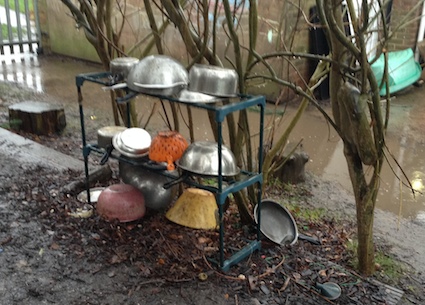
The open and closed element of this kitchen has several manifestations. Firstly children like peekaboo games. The option to open and close doors, move hatches from open to shut and back again, places to step in and out of – to be seen and to be hidden are fascinating to children. The oven, the shelving and other features within the mud kitchen provide plenty of these options. Around the back of the mud kitchen is a thin space between the panel and the boundary wall. I thought this was a possible space that added to this dimension as children could disappear and reappear.
- Children’s desire to transport
Children like moving materials as part of their play. The open access layout of this mud kitchen enables children to come and go as they need to. There are lots of containers which children can use. Many of these are household objects. This means that the play within the mud kitchen can be extended to include as much or as little of the outdoor space that is needed.
It was a thoroughly wet morning when I visited. Puddles were everywhere. The children who were outside all at some point investigated the puddles and transported water. To one side of the mud kitchen is a water butt that collects rainwater.
Tom mentions that children will spill anything they transport. He provides a big bin for children to pour things into from his sand table. Near to the mud kitchen there is an old turtle sand tray. It no longer has sand in it. Upon inspection, it was evident that this was used as a dumping and mixing place. Interestingly, many of the big tyres around the outdoor space had a similar use too.
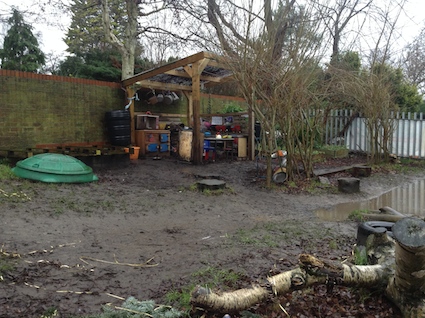
- Open-ended opportunities
The mud kitchen is a place where children can be creative and inventive and can visit intensively or pop in and out as part of their play in other parts of the grounds. For example, on several occasions I saw children visit the area to collect resources they needed elsewhere. I was offered a cup of coffee but before it reached my hand, the child had decided it would be an ideal vessel to hold some water to paint over a wall. So the child, container and paint brush disappeared out of the area. Tom notes “children will pursue their own unique physical challenges when working on, at or next to an apparatus.” This certainly strikes a chord with this mud kitchen.
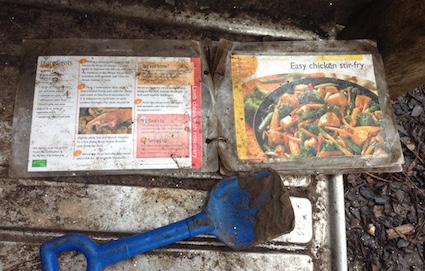
Several other additions interested me. Like many mud kitchens, there are raised beds for gardening to the right of the mud kitchen providing a source of smells, textures and even tastes! Within the mud kitchen there was a relevant range of environmental print. A recipe book had been created from recipe cards. A comic strip relating to mud pies was attached to the wall. Photos of the children were also present.
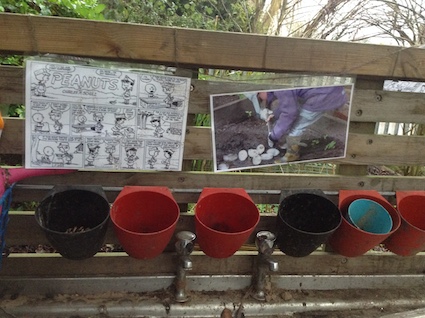
Menna felt that the Quackers mud kitchen was very much like a good home kitchen. Often a kitchen is the hub of a home. People come and go to make cups of tea, find food and drop off stuff. Yet at other times, it is the gathering place, where people meet, eat, mix, socialise and simply hang out there.
In Tom’s words “children will always devise new and novel activities and explorations with the materials presented that are tangential to the apparatus itself.” I think perhaps this is why the Quackers mud kitchen is so successful. The feature, its location and the type of resources which are present enables endless investigations and explorations – not just within the mud kitchen but extending well beyond and into the rest of the play space.
The question I am left wondering is whether Tom’s Dimensions and Elements have universal application to any play space or area. That his years of observing children, creating, exploring and investigating with a sand table has resulted in a gift for children and practitioners everywhere, inside and out to adapt and use to create open-ended play areas. Now there’s a research action project waiting to happen! 🙂
This blog post was originally published in February 2016.



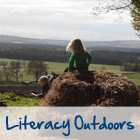
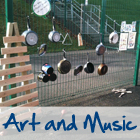
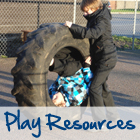
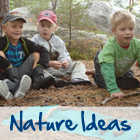

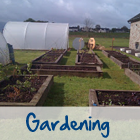
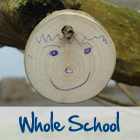



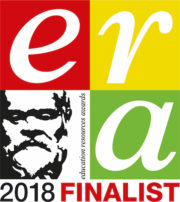
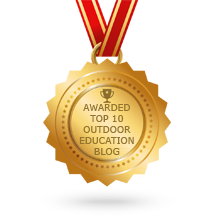


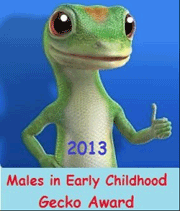


My girls love mud kitchens, what fun!
Agreed!
I was fascinated reading this and comparing how many of these features we have in the Coombe Mill mud kitchen. Did we have that in place when you came to visit? I have a feeling it is since then. But I see many of the features mentioned, ours had layers, different spaces, hanging things and enclosed on 3 sides but what I really notice is the desire to transport. Each week I collect mud kitchen utensils from the sand pit and return them to their place. Clearly this moving of items and extending play to the play fortress up the hill is expected behaviour. Thank you for sharing this with me on #CountryKids
Hello Fiona
The mud kitchen must have arrived after my wonderful week with you. I think that it’s interesting that you’ve picked up on the transportation theme. I think this is so often overlooked in relation to a mud kitchen where the focus can be on the mixing, making, baking aspect of play.
Best wishes
Juliet
My kids love to transport and I am often finding things scattered all over the garden. A mud kitchen is firmly on the wish list
It may be worth having a big bin/container somewhere that they know they can put things into… a top tip from Tom Bedard.